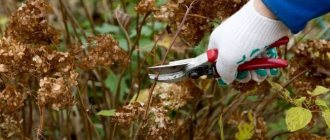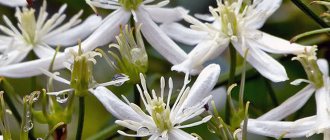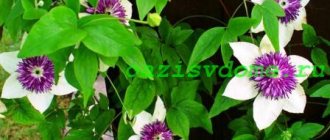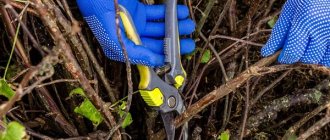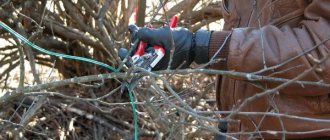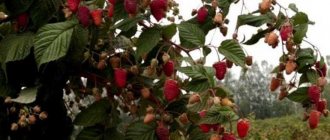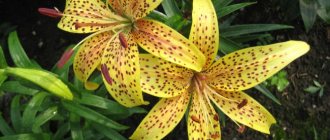Honeysuckle got its name in honor of the famous German botanist Adam Lonitzer, who worked in the Middle Ages. It is worth noting that the scientist himself wanted to call the culture honeysuckle for some of his own reasons. This shrub is perfectly resistant to winter and is unpretentious in serious care. Its flowers are very delicate and beautiful, and there are also fruits. It is worth noting that caring for honeysuckle in the fall and preparing for winter are mandatory.
Transfer
Some gardeners replant shrubs in the spring, but it is better to carry out this procedure in the fall, since honeysuckle is a shrub with an early growing season. So, already from the end of June the plant enters the dormant stage, which lasts until the beginning of March. According to the observations of gardeners, during this period dormant buds of shrubs do not bloom. Consequently, bushes can be replanted from August until October.
The transplant itself is performed according to the following instructions:
- Select a new place for transfer in advance.
- Dig a hole that should be several times larger than the original one. Introduce humus into it.
- Do not move the bush to a new place, but drag it along the ground. To protect the plant from possible damage, it can be loaded onto burlap and carefully dragged to a new location. At the same time, it is extremely important to leave a lump of earth on the roots.
- Plant the bush, deepening it to about 5-6 m. At this point, the transplant will be successfully completed.
When transplanting shrubs, you need to act extremely carefully so as not to damage the sensitive root system of honeysuckle.
When and where to start preparing honeysuckle for winter
Honeysuckle is an unpretentious plant; many of its species can withstand Siberian winters even without shelter. But in order to grow a rich harvest of berries, so that the plant has a well-groomed appearance, it must be monitored.
The harvest and dormant period for the shrub begins earlier than for most fruit trees. By the end of summer, the plant must begin to be prepared for winter . This includes pruning branches, removing weeds and dry branches, and feeding the plant. Gardeners have differing opinions regarding fallen leaves. Some believe that this is additional protection from the cold and it is not necessary to remove dry leaves. Others call for the removal of fallen leaves, in which garden pests hide for the winter.
Trimming
Like most shrubs, honeysuckle bushes well: the plant quickly forms new shoots and shoots. So, shoots form on old branches, and young shoots grow from the basal buds. In addition, it appears in the root system.
To prevent random branching of the bush, it is worth regularly cutting off old and damaged branches. This manipulation also performs a number of other tasks:
- strengthens the bush before winter and gives it a beautiful shape;
- improves plant productivity and rejuvenates it;
- stimulates abundant flowering next season;
- allows you to preserve the quality characteristics of berries, the taste of which may suffer from lack of sunlight and poor ventilation.
You need to trim the bushes very carefully, since honeysuckle of edible varieties grows slowly, so it will take a long time to resume its lost shape.
When is it better to carry out such an important garden manipulation, which bushes should be pruned and how, should be considered separately.
When is it better to prune - autumn or spring?
Honeysuckle quickly awakens from hibernation, so pruning it in the spring is quite dangerous. In addition, if you are late with this manipulation, you can cause harm to the fruit buds.
So, the best time to prune a bush is November, when the air temperature at night drops below 0°C and the bush sheds its leaves. It is extremely undesirable to carry out this procedure earlier than the specified period: if you hastily prune before frost, buds may develop that will freeze out with the onset of cold weather.
Which bushes should I trim?
Shrubs are fully pruned for the first time at the age of 5-6 years. In the fall, when the leaves of thickened bushes fall off, you will need to remove old, dry, damaged and short branches, as well as the ends of shoots with poor growth. The fruits grow on annual shoots, so they do not need to be touched.
Unlike other shrubs, edible honeysuckle varieties do not require annual pruning. So, if everything is done correctly, then the next treatment should be carried out no earlier than in 2-3 years. When the plant reaches 8 years old, the bush is subject to hilling and rejuvenation by cutting off all old branches and the remaining young growth on the lower part of the skeletal branches.
Of course, young bushes, older than 2-3 years, cannot be subjected to large-scale pruning, but some gardeners recommend cutting out the extra shoots that grow in the center of the bush. Such an intervention allows access to the sun's rays inside the bush and increases the air permeability of the plant.
How to prune?
When the plant reaches five years of age, it is fully pruned according to the following instructions:
- Remove dried or damaged shoots from the crown. If only parts of them are damaged, then they should be cut off. Of course, there is no need to trim the entire branch if only its tip is damaged.
- On a skeletal branch, remove the top and inward branches to prevent darkening of the bush and reduction in the size of the berries. The cut should be made in the middle of the branch, not near its base.
- Cut off branches that bend downward excessively to ensure proper ventilation for the plant.
- Trim branches that are unbranched and shoots that are irregularly shaped, such as excessively gnarled or bowed. After pruning is completed, an average of 8-15 shoots should remain on the bush. In any case, in order for the shrub to withstand the winter and bear fruit well in the future, at least 5 healthy shoots must be left on it.
The gardener will tell you exactly how to prune honeysuckle in the following video:
Experienced gardeners do not recommend pruning young branches, since it is on them that a larger number of buds are formed.
The procedure for rejuvenating the plant must be carried out with the utmost care, since the branches are easily broken and damaged.
Nuances of processing young and old honeysuckle
Features of pruning depend on the age of the plant. Unlike many berry bushes, honeysuckle does not need pruning after planting, since such intervention will stop the development of the plant and significantly affect the fruiting phase. So, until the plant is 5 years old, only three types of branches should be removed from the bush:
- growing inward;
- dried out;
- broken.
With such gentle pruning, the branches will not intertwine with each other, and more sunlight and moisture will get into the center of the bush. Thus, all conditions for the normal development of the plant will be recreated.
As for old abandoned bushes, to rejuvenate them you will need to remove all the old branches or completely trim the plant to a stump, using a pruner to cut off all shoots more than 40 cm high. Such garden manipulations are best carried out after the leaves fall or, in extreme cases, in early spring before awakening plants.
After anti-aging pruning, experienced gardeners advise tying the bushes. To do this, you need to bury wooden or metal pegs into the ground along their perimeter, and then tie them with a rope just above the place of the cuts. Such support will not allow the plant to fall apart and prevent breakage of the shoots.
When is it better to plant honeysuckle - in autumn or spring?
It all depends on what kind of seedling you bought: with a closed or open root system. If the seedlings were bought in a container, that is, with a closed root system, then it can be planted throughout the entire season, from early spring to late autumn. The bush has undamaged rooted roots, and such a plant will quickly take root.
Seedlings with an open (bare) root system are another matter. They need to be planted in autumn or early spring before buds open. Since culture wakes up very early, this is quite problematic. Therefore, planting is best done in the fall, starting from September - October. And don’t be afraid, if it’s already snowing outside, it’s still not too late to plant a bush on your site. In the remaining time before the onset of frost, the bush will have time to take root, and in the spring it will quickly begin to grow.
Sometimes, looking at a seedling, they see that its branches are dry. Don't let this bother you either. The plant ends its growing season early and sheds its leaves, so when purchased the plant comes without leaves. But in the spring, when sap flow begins, live buds quickly appear on the branches, and then foliage.
Watering and soil treatment
Honeysuckle is a moisture-loving plant, so it needs regular watering even after harvest. Of course, in the fall you need to reduce its frequency and abundance. So, the watering rate is 1.5 buckets per bush, but in the case of a dry autumn, the volume can be increased to 2-2.5 buckets. The soil should be moistened as it dries.
When watering, the area should not be loosened or dug up, since the root system of honeysuckle is superficial and may suffer from such manipulations. In this case, you should change the layer of sawdust or compost mulch from time to time, since it retains moisture well and prevents the development of weeds.
Planting honeysuckle in autumn
It is better to immediately plant the shrub in a permanent place. It is better not to dig in, as the plant tolerates low temperatures well even without snow.
A hole measuring 60x60 cm and a depth of 40-50 cm is prepared in advance. Add to the hole
- Humus - 1-1.5 buckets,
- Granulated horse or bird droppings - 2 handfuls,
- Compost – 10-20 l,
- Biohumus – 4-5 l,
- Wood ash – 1 l,
- The drug “Shine-2”, which prevents the development of fungi and other pathogenic bacteria, preventing the development of various diseases.
It is not necessary to use all of the listed components at the same time, but the soil in the hole must be fertile. And there must be ash there.
If the soil in the area is dense, add sand or vermiculite to the hole.
The contents of the hole are thoroughly mixed, and you can begin planting or transplanting honeysuckle.
When planting shrubs, it is good to immediately use border tape. It will save time on caring for the plant, prevents the growth of weeds, and it will be more convenient to mulch the root space. And it looks more aesthetically pleasing.
Planting a seedling with an open root system
It is better to first soak a bare-rooted seedling in a solution of natural stimulants. If the plant has long roots, they can be shortened a little. If you look carefully, there is a fork of branches at the base of the seedling; when planting, it needs to be buried. Or the seedling is planted on a slope and buried until the next bud. That is, when planting, the seedling is buried 5-7 cm.
A tubercle is made in the hole and a seedling is placed on it. The roots are straightened so that they hang from the tubercle and do not bend.
Holding the plant with one hand, fill the hole with the other and compact the soil near the bush. Then the seedling is well watered
and mulch with a thick (about 10 cm) layer of mulch. Mulch will prevent weeds from growing and retain moisture in the soil.
How to plant a seedling with a closed root system
If the seedling has a closed root system, then planting it will be even easier. To do this, release the root system of the plant by cutting the plastic bag. Place the seedling in the prepared hole with nutrient soil by transferring it, pour water into the hole.
Holding the plant in an upright position with one hand, fill the hole with soil with the other, compact it firmly so that the plant does not tilt under the pressure of the wind. Water the plant well again and mulch.
Top dressing
Timely saturation of the soil with the necessary nutrients will contribute to the good development of the bushes, their abundant flowering and fruiting. In this case, the plant should be fed for the first time at 2 years of age.
First of all, honeysuckle needs organic matter. It will make the soil more fertile and activate the development of soil bacteria necessary for berry bushes. So, once every 3 years the following should be added to the soil:
- rotted compost;
- humus;
- manure;
- chicken droppings.
This is enough to feed the bush. Potassium-phosphorus fertilizers will also be an excellent fertilizer for the plant. In the autumn, the gardener should add 100 g of ash, no more than 20 g of potassium salts and no less than 30 g of double superphosphate per 1 sq. m. m plot. For a complex effect in the spring, before the buds open, honeysuckle can be fed with ammonium nitrate (15 g per 1 sq. m) or treated with a urea solution.
The gardener shares his experience of feeding honeysuckle in the video below:
The gardener should not overdo it with nitrogen-containing fertilizers, as they cause excessive growth of honeysuckle. As a result, this leads to the opening of the buds during the onset of frost and the death of the plant.
Protection from pests and diseases
Honeysuckle is rarely attacked by pests and develops various diseases, but preventive measures should not be neglected. So, once every few years after leaf fall, it is worth spraying each bush with a urea solution (700 g of granules per bucket of water).
Despite this treatment, sometimes the bush is attacked by pests. For example, bullfinches can feast on the buds of the plant, and small rodents (mice, hares) on its bark. The sad consequences of such an attack will be obvious only in the spring, when the condition of the affected bushes can be fully assessed. So, in order to prevent such pest attacks, you should protect the honeysuckle from rodents and birds by covering the planting with a net.
In autumn, it is also extremely important to carefully remove the entire area and the tree trunks of shrubs from last year’s foliage, which can become a favorable environment for the development of bacteria and the activity of harmful insects.
Time and method of autumn vaccination
In the fall, honeysuckle grafting is carried out after the leaves fall, so that the scion has time to take root, but does not grow and does not produce new buds. This procedure is carried out according to simple instructions:
- Using a sharp tool, trim the scion and rootstock. The cut should be made obliquely.
- Connect the scion and rootstock tightly, securing the junction with tape.
- Cover the top with film and a sheet of paper.
- Wrap the last layer with twine.
Vaccinations can be checked after 3 weeks.
Sheltering honeysuckle for the winter
Do I need to cover the bushes before wintering? It depends on which of the two types of varieties the honeysuckle growing on the site belongs to:
- Frost-resistant (winter-hardy) . These varieties of plants can withstand even severe frosts, so they do not need winter shelter. Thus, flower buds can withstand temperatures down to -40°C, and growth buds can withstand temperatures down to -50°C. To protect the plant for the winter, you need to tie the branches into a bundle and bend them towards the ground. This will prevent branches from breaking off under a heavy layer of snow.
- Decorative . Not as hardy as frost-resistant varieties, so they need shelter. This especially applies to climbing vines. So, in the fall it is necessary to bend the branches of the bush to the ground, and then sprinkle spruce branches or sawdust on top. In addition, the plant can be covered with rolled covering material.
Snow cover will additionally protect the bushes from the cold.
After the first winter, the berry season opens with honeysuckle, a plant of the genus of creeping, erect or climbing shrubs from the honeysuckle family. Of course, in order to get a good harvest of berries with a specific, slightly bitter taste, you will need to properly treat the bushes in the fall according to the above rules, because only this will allow the plant to survive even the harshest winter.
0
0
Copy link
Typical mistakes of novice gardeners
Speaking about growing honeysuckle and preparing this plant for winter, you must strictly follow the rules of care. Beginning gardeners often make mistakes by losing plants. Among the most typical are:
- Young shoots are removed, after which the plant cannot bloom and bear fruit.
- Bushes that are too young and have not yet reached maturity are pruned. The plant becomes weak, it is impossible to wait for the harvest.
- They neglect the shelter of decorative varieties of honeysuckle.
Following the simple rules of autumn care will allow you to preserve the plant, which will delight you in the summer with beautiful flowers, and some varieties with delicious fruits.

